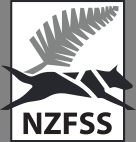
New Zealand Federation of Sled Dog Sports
Sleds and other bits
Like equipment in all sports early gear sometimes leaves plenty of room for improvement. Some of the early sleds made were copies of North American sprint sleds and were very good some are still in use and performing very well Some however were not as effective. While most sleds are made of American Ash or Oak some timbers used in early NZ sleds were Hickory, NZ Pine, and in one case NZ Red Beech.
As the sport has grown different types of 'sleds' have appeared. The two main types are the basket sled and the toboggan sled. Within the basket type sled, a number of variations are appearing from some quite rigid models to some that are very flexible, and at least one ‘telescopic’ sled. Within the basket sled type full bed and 1/2 bed types exist. Full beds are used more for longer distances to allow a larger 'cargo' to be carried. 1/2 beds are obviously for short sprints where the only need is for sufficient space to bag a dog if necessary. While the majority of sleds used are 'homebuilt' a number of very good imported sleds are now about. Toboggans are usually flat bed (sometimes referred to as low bed) and raised bed. The flat bed often have the entire under part of the toboggan in contact with the snow. In soft snow this distributes the load over a greater surface area. When these flat bed toboggans do have runners they seldom raise the bed of the toboggan any more than I - 11/2 inches above the base of the runners.
Raised bed toboggans as the name suggests raises the beds much higher but this usually is still only 5 6 inches above runner level. Possibly the greatest noticeable difference between a sled and a toboggan is that toboggans are much more rigid to the extent that flex almost does not exist.
Sleds/toboggans come with a 'price-tag' to suit all budgets. Good "value for money" NZ built sleds start from about NZ$800 upwards while good imported sleds start at around NZ$3500 to $4000 plus.
It is generally accepted that the very light weight sprint sleds which are normally of the basket type are best suited to smaller teams, i.e. 6 dogs or less. As distance and team size increases, so does the 'weight' of the sled as the necessity to load more equipment rises. Once you get to the distance races (not yet seen in NZ) this is almost without doubt the 'home' of toboggans. With long low flat beds these are able to carry quite large loads. In some cases 100's of kilograms.
Getting started in sled racing can be expensive if you buy all new gear and buy the best money can get. If you can find someone who has been, or is involved in the sport, then the best thing is to talk to them. With the sport growing some very good second hand equipment occasionally comes on the market. Most of this changes hands quickly through word of mouth contacts. There are also a small number of generous people who loan their sleds to enthusiasts.
Possibly one of the most under-estimated aspects of sledding in NZ is the physically demanding nature of the sport. This is largely attributed to the fact that most snow racing is limited to ski fields. Quite simply ski fields in NZ mean hills. Hills require a degree of fitness - for MUSHER and DOG. To compete successfully you need to address human and dog fitness.